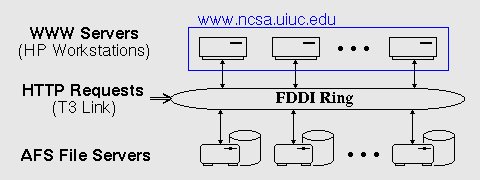
Figure 1: Real-time data collection and analysis architecture




Journal reference: Computer Networks and ISDN Systems, Volume 28, issues 7–11, p. 1457.
Due in large part to early development of the Mosaic WWW browser by
the National Center for Supercomputing Applications (NCSA), the access
load on the NCSA WWW server remains extremely high.
Using the NCSA WWW server as a high load testbed, we describe Avatar,
a virtual reality system for real-time analysis and mapping of WWW server
accesses to their point of geographic origin on various projections of
the Earth.
As HTTP protocols expand to demographic data, the Avatar architecture
can be extended to correlate this data as well.
Keywords:
virtual reality, demographics, access pattern analysis,
performance analysis, information mining
In March 1994, the WWW ranked eleventh among the most used NSFNet backbone services [12]. At that time, WWW data accounted for less than three percent of all NSFNet backbone packets. By March 1995, WWW traffic was ranked first and accounted for almost twenty percent of the NSFNet backbone packets. This growth trend continues unabated as new WWW sites are added each minute.
Given current use of the WWW for scientific and educational information sharing and its emerging use for electronic commerce, studying access patterns is an important first step in understanding network implications and in designing future generations of WWW servers that can accommodate new media types and interaction modes. However, the large number of requesting sites, the diversity of WWW data types (text, data, images, audio, and video), and the multiplicity of server performance metrics (e.g., network packets and page faults) make data correlation and understanding difficult. Proposed HTTP protocol extensions will add demographic data, further complicating correlation and heightening the need for sophisticated analysis techniques.
To support WWW performance analysis, we expanded Avatar, a virtual reality system designed to analyze and display real-time performance data [17], and we applied it to the analysis of WWW traffic. One variant of Avatar supports real-time display of WWW server accesses by mapping them to their geographic point of origin on various projections of the Earth. By allowing users to interactively change the displayed performance metrics and to observe the real-time evolution of WWW traffic patterns in a familiar geographic context, Avatar provides insights that are not readily apparent via more traditional statistical analysis. Moreover, it can be extended to accommodate demographic and point of sale information for correlation of electronic commerce patterns.
The remainder of this paper is organized as follows. First, we describe the architecture of the NCSA WWW server and the performance data recorded by the server. We build on this by describing real-time data analysis software that can map WWW server requests to their geographic origin. This is followed by a description of the Avatar virtual reality system and its geographic representations of WWW traffic, by a discussion of our experiences, and by discussion of future directions. Finally, we summarize related work and our conclusions.
Via statistical analysis and our virtual reality tools, we have identified server bottlenecks and typical user access patterns [10,11]. As a context for discussion of our data analysis and visualization experiences, we first describe the architecture of the NCSA WWW server and provide a more detailed description of the recorded performance data.

Despite the multiplicity of servers, NCSA advertises a single domain name (www.ncsa.uiuc.edu) as its WWW server address. To equitably distribute incoming requests across the component servers, a modified Domain Name Server (DNS) at NCSA distributes the IP address for a different component server in response to each DNS query. These IP addresses are distributed in a round-robin fashion with a recommended time to live (TTL) of 15 minutes. This results in reasonably well-balanced load unless one or more remote systems ignore the recommended TTL and continue to cache the IP address of a single server.
Under this scheme, each server operates independently of the others. As demand grows, new workstations can be added to the server pool without reconfiguring existing servers, and workstation failures need not bring down the server complex.
Each of the access log entries consists of seven fields [13], including the IP address of the requesting client, the time of the request, the name of the requested document, and the number of bytes sent in response to the request. Despite the apparently limited information, it is possible to compute many performance metrics from the log entries and to glean several insights. For example, the extension of the file requested identifies the type of document requested and, with the number of bytes sent, suffices to compute the distribution of requests by data type and size.
Based on the file extensions, requests can be partitioned into at least six broad categories: text, images, audio, video, scientific data, and other. Within these divisions, we have classified text files as those with extensions such as html, txt, ps, doc, and tex. Graphics file extensions include gif, jpg, and rgb as well as other formats. Audio file extensions include au, aiff, and aifc. Video file extensions include mpeg, mov (QuickTime), and others. The scientific file category includes hdf, the NCSA Hierarchical Data Format (HDF). Finally, any remaining requests are placed in the "other" category.
The IP addresses provide additional information. By converting an IP address to a domain name, one can determine the components of the domain name and, often, the location of the requester. In the United States, common domain name extensions include education (edu), commercial (com), government (gov), and other (us). Outside the United States, countries typically use the ISO 3166 (1993) two letter country codes, or the network (net) extension. By exploiting these two letter country codes, one can identify the request's country of origin. As we shall see, IP addresses and domain names are the starting point for finer geographic distinctions, including mapping requests to specific latitude and longitude.
Simply put, the httpd log files provide a wealth of information about incoming WWW requests. Aggregating individual requests shows larger, evolving patterns that are striking when visualized in real time.
Unlike users of WWW browsers, those who deploy WWW servers have a growing interest in understanding the geographic dispersion of access patterns. As digital cash makes electronic commerce via the WWW practical, providers of products can gain a competitive advantage by mining access patterns, much as large retail organizations currently mine point-of-sale information. For example, understanding which parts of the country (or world) most frequently purchase particular items from an online catalog is a major advantage --- given the geographic location of an incoming IP address, one can tailor the WWW server response by highlighting particular product types. Likewise, data on requester demographics [19] and correlation of this data with geographic information systems would permit selected targeting of product information. Finally, commercial Internet service providers could exploit knowledge of user access patterns to add new services in selected geographic regions.
To map IP addresses to geographic location, we first determine the domain name. For locations outside the United States, the suffix of the domain name typically is an abbreviation of the country name. In these cases, we map the request to the capital of the country. For all other cases, we query the whois database, retrieving the textual data associated with the IP address. We then search this data for city and country names. If a city or country name is found, we then retrieve the latitude and longitude from a local database of city and country names.
Because querying the whois database is expensive, often requiring a second or more to retrieve the desired data, we store the latitudes and longitudes of previously matched IP addresses to avoid repeated and unnecessary whois queries. If the whois query returns information that does not contain a city or country name, we record the IP address to avoid further, fruitless queries. Off-line, many of these failed queries can be identified and corrected in the database.
With our current database (35,000+ entries), about 95 percent of all requests to the NCSA WWW server can be successfully matched to latitude and longitude using only local data, 4.5 percent have undetermined latitudes and longitudes, and the remaining 0.5 percent must be found in the remote whois database. As our database continues to expand, the fraction of unresolvable requests continues to decline.
Despite our high success rate, network firewalls and national online services limit the accuracy of the latitudes and longitudes. For instance, an America Online (AOL) user might connect via modem from Irvine, California and access the NCSA What's New page. That person's IP address (aol.com) would yield Vienna, Virginia as its location because that is the site of the AOL headquarters. Similar problems arise with large, geographically disperse corporations that maintain a single Internet point of contact. Fortunately, such cases can be identified by name and can often be parsed by decomposing the domain name (e.g., intgate.raleigh.ibm.com is easily identified as an IBM site at Raleigh, North Carolina).
Although the primary use of our position database is to support geographic visualization of WWW request patterns in virtual environments, a WWW browser interface can be found at http://cello.cs.uiuc.edu/cgi-bin/slamm/ip2ll/. This interface exploits the Xerox PARC and US Census Tiger map servers to display the location of the IP address on a simple, two-dimensional map.
To integrate the geographic mapping of WWW requests with our existing analysis software and to support real-time data reduction and interaction, we decoupled analysis of the WWW server logs from the virtual reality system. The only medium of data exchange between the virtual environment and the analysis system is the Pablo self-describing data format [2], an extensible data meta-format with embedded data descriptions. This decoupling improves system performance and increases the flexibility to adapt the system to evolving goals.
By separating data visualization from data processing, display software development and processing software development can proceed in isolation. The display software currently supports virtual reality hardware such as head-mounted displays (HMDs) and the CAVE virtual reality theater. With the isolation, new displays --- such as a VRML representation --- may extend display support to the 2D desktop environment. For the data processing software, the isolation simplifies the integration of analysis extensions and the integration of new analysis mechanisms such as a relational database of access pattern, performance, and demographic data.
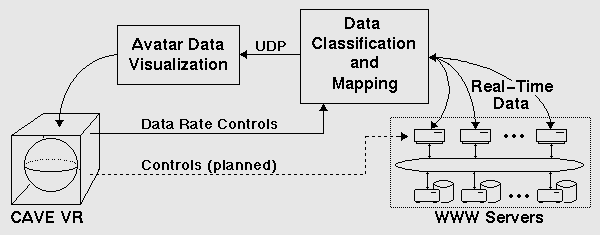
As Figure 2 shows, data visualization and data classification execute concurrently on separate platforms. The data analysis software incrementally retrieves the WWW server logs via TCP network sockets, classifies the domains and file types, finds the geographic location of the IP address, and packages the data in the Pablo Self Defining Data Format (SDDF) [15]. The SDDF allows Avatar to inter-operate with performance instrumentation and analysis tools. The packaged SDDF records are sent via UDP sockets to the Avatar virtual reality software. Avatar then renders the data in the NCSA CAVE [7], an unencumbered environment for immersive data analysis. In the following section, we describe the data immersion software in detail.
To date, we have developed three different display metaphors for performance data: time tunnels, scattercubes, and geographic displays. Time tunnels permit analysis of time lines and event driven graphs of task interactions (e.g., parallel or distributed tasks).
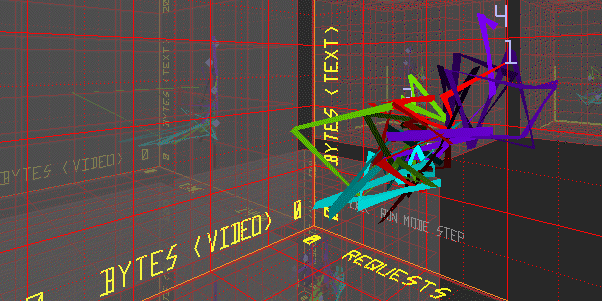
Scattercubes, a three-dimensional generalization of two-dimensional scatterplots, support analysis of very high-dimensional, non-grid based, time varying data. As an example, Figure 3 shows one three-dimensional projection of the dynamic behavior of the NCSA servers [18]. In the figure, the three axes correspond to one minute sliding window averages of the number of bytes of data transferred to satisfy requests for video clips, bytes transferred for text requests, and number of requests. The colored ribbons represent the trajectories of the NCSA WWW servers in the metric space. Through the translucent walls of the display, one can see three-dimensional projections of other metric triplets. In the virtual environment, one can fly through the projections to explore the data space, interactively rescale the axes, and enable or disable the history ribbons.
To complement the scattercube display of statistical WWW data and to represent the geographic dispersion of WWW requests, we developed a new display metaphor based on projections of the globe of the Earth. This metaphor is described below.
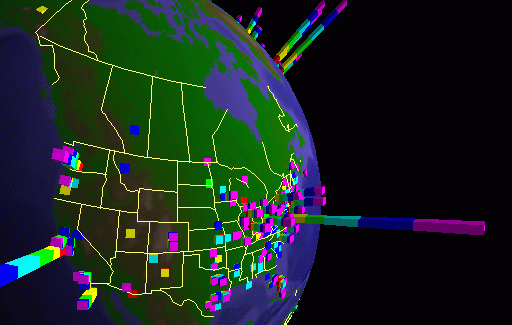
As Figure 4 shows, the globe consists of a texture map of the world on a sphere. The surface of the sphere includes altitude relief from the USGS ETOP05 database and political boundaries are drawn from the CIA World Map database.
On the globe or its projection, data can be displayed either as arcs between source and destination or as stacked bars. The former can be used to display point-to-point communication traffic [3], with the thickness, height, and color of the arc representing specific data attributes.
Stacked bars convey information through three mechanisms: position, height, and color bands. For WWW traffic, each bar is placed at the geographic origin of a WWW request. As we shall see in the description of our experiences, the bar heights show location-specific attributes of the requests, typically the number of bytes or the number of requests relative to other sites. The bar color bands represent the distribution of document types, domain classes, servers, or time intervals between successive requests.
The HMD version of Avatar includes speech synthesis and recognition hardware for voice-directed commands, and both the HMD and the CAVE versions use six degree of freedom trackers for head and hand (three-dimensional mouse) position location. Voice commands have the benefit that they can be executed at any time, and they do not consume space in the rendered scene. However, they require the user to be familiar with the command vocabulary.
To support both the CAVE and HMDs, while providing a virtual reality interface familiar to workstation users, the majority of all Avatar controls are realized via a familiar menu-based interface for data analysis and display. Later, we discuss the limitations of this approach. We implemented a library of windows that have labels, buttons, pull-down menus, sliders, and scroll boxes. Users select windows and menu items by pointing the three-dimensional mouse; a cursor drawn on the window indicates where the user is pointing, and audio feedback confirms menu selections. These windows can be moved, opened, and closed via the mouse and can be accessed from any location that has an unobstructed view of the desired window.
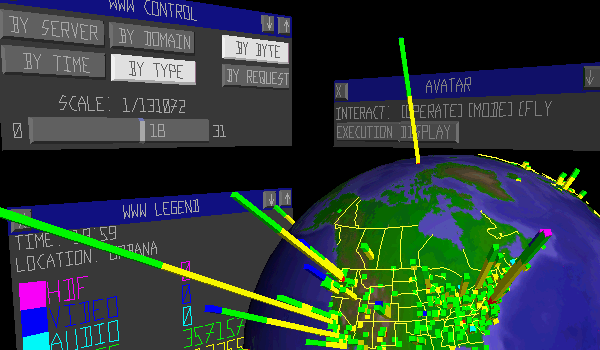
As shown in Figure 5, the menus for interaction with the geographic metaphor's display of WWW data control the scaling and position of the globe. The size of the globe and the height of the bars are controlled by sliders. The globe may be rotated by pressing buttons that increment or decrement the rotation speed, and a pull-down menu provides the option of warping to a predefined location (e.g., North America or Europe). Finally, one can select the characteristics of the displayed data.
In addition to providing a control mechanism, the windows convey additional information about currently displayed data. In Figure 5, they show the current time, a color code for the stacked bars, and numerical values associated with the color code. Using the mouse, one can select a particular geographic site and see the city name displayed with the legend.
By separating the structure of data from its semantics, the Pablo SDDF library permits construction of tools that can extract and process SDDF records and record fields with minimal knowledge of the data's deeper semantics. Via this mechanism, Avatar can process WWW data, parallel system performance data, and generic statistical data with minimal software changes.
SDDFA
#1:
"Mosaic_Metric" {
int "time";
int "server";
int "size";
int "file_type";
int "domain_type";
float "latitude";
float "longitude";
char "city"[];
char "state"[];
char "country"[];
char "hostname"[];
};;
"Mosaic_Metric" {
1300, 1, 12000, 2, 3, 40.112, -88.200,
[6] "URBANA", [2] "IL", [3] "USA",
[8] "www-pablo.cs.uiuc.edu"
};;
Figure 6 shows one of several record descriptors used for the WWW data, and Figure 7 shows one possible record instance associated with this descriptor definition. The timestamp is given in minutes past midnight, the server number is represented by an integer identifier, and the the request domain types are enumerations. The possible file types are text, image, audio, video, hdf and "other." The domain types differentiate the US sites. The possible domain classes are edu, com, gov, ca (Canada), Europe and "other."
Because the Avatar software has no embedded knowledge of these classifications, one can add or change the classification without change to the display software. Indeed, the scattercube display of Figure 3 relies on other SDDF records that contain forty metrics on server access patterns, network performance, and processor utilization.
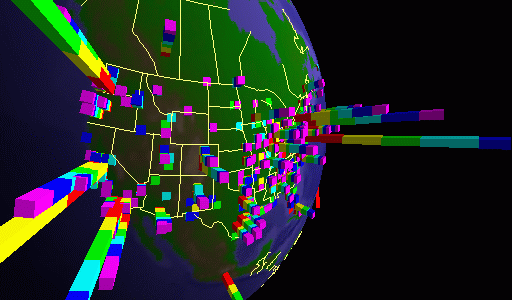
The most striking attribute of Figures 4 and 8, two snapshots of a single day separated by twelve hours, is the wide variation in request frequency. Sites that act as firewalls, typically large corporations and commercial Internet service providers, appear as the originating point for the largest number of accesses. Smaller sites, typically universities, government laboratories, and small companies, constitute a large fraction of all accesses, but they are geographically distributed more uniformly. Reflecting the evolution of the Internet, visual comparison of typical days in the life of the NCSA WWW server from 1994 and 1995 shows that government and commercial access is growing much more rapidly than that of educational institutions.
Second, the distribution of the sites follows population lines --- in the United States, these are the coastal areas and regions east of the Mississippi River. Because inexpensive Internet access is limited outside universities and larger urban areas, these sites originate the largest number of requests. Access to the NCSA WWW server from outside the United States is common, though far less frequent than from sites in the United States. There is little traffic from South America, Africa, or countries of the former Soviet Union, but Europe and the Pacific Rim have thriving WWW communities.
As one would expect, the periods of heaviest activity and the distribution of requests by Internet domain track the normal business day. In the early morning hours (Eastern Standard Time), Europe is a major source of activity at the NCSA WWW server. As the morning progresses, the east coast of the United States becomes active. Near the middle of the day, the activity in Europe fades, while the United States requests peak. In the evening, the United States west coast has the highest level of activity.
Interestingly, the characteristics of the requested documents also change with time of day. Requests for audio and video files are much more common during the normal business day than during the evening hours. During the evening, text and image files predominate. We conjecture that this reflects both lower bandwidth links to Europe and Asia and low speed modem-based access via commercial service providers. This variation has profound implications for the design of future WWW servers and browsers --- based on the capabilities of the system hosting the browser and the bandwidth of the link connecting the server and browser, the server and browser should negotiate the resolution of images to be transmitted and any guarantees for quality of service (e.g., for video).
Finally, using Avatar we were able to track failures of the NCSA server load balancing mechanism. Large load imbalances can result when certain locations, particularly firewall sites, cache the IP address of a single workstation server longer than the recommended fifteen minutes and repeatedly fetch data using that address. Statistically, we knew this occurred, but we had never seen its effects. With the geographic display of which servers satisfied requests from particular sites, we could see the effect in real time. Indeed, we found sites that used just one IP address for an hour or longer.
At present, Avatar processes and displays data from a single WWW server. However, as the WWW continues to grow and diversify, understanding the global impact of WWW traffic becomes more difficult. Fortunately, a substantial fraction of current WWW servers export some statistics on access patterns. Combining data from these servers would provide a global view of access patterns not presently possible. In addition, in remote demonstrations we have found that the one minute updates of server behavior used by Avatar can easily be transmitted across even heavily loaded network links, making global analysis feasible.
A second limitation of Avatar is the inability to adaptively cluster data based on density. High population areas (e.g., New York and Los Angeles) are major sources of WWW traffic. Variable resolution reduction and data display would allow us to zoom closer to selected regions and gain a more detailed perspective than is presently possible with fixed region clustering.
Third, related to variable resolution, we would like to make finer mapping distinctions outside the United States. To date we have mapped U.S. sites to the city of origin, Canadian sites to their provincial capitals and other sites to their country capital. The whois queries often return non-U.S. cities which we cannot place on the globe due to the lack of a world-wide city databases that hold latitude and longitude information. While such databases do exist, they are often not readily available to the public. With the incorporation of new databases we plan to enhance the mapping capabilities of the globe display. We are currently in the process of adding such databases for Canada and the United Kingdom.
Fourth, geographic displays are but one way to study WWW server data. In [18] and the Avatar description, we presented an alternate perspective, based on statistical graphics, that shows the time-evolutionary behavior of server performance metrics (e.g., page faults and context switches) and their correlation with request types. Ideally, these two displays should be coupled, allowing one to correlate multiple display views.
Fifth, a much richer set of statistics is needed. As WWW servers begin to support financial transactions, recording details of the transactions and mining that data for competitive advantage will become increasingly important. In the future, the transactions will include demographic data [19] that will add a rich set of dimensions to the geographic display. WWW users may provide profiles about their interests and other personal information to receive WWW pages tailored to their desires. Commercial sites could use the geographic display of demographics to correlate their cyber-customers with their real-world customers. Displays such as those in Figure 5 provide the metaphor for interactive query and display of data correlations.
Finally, one of the more difficult implementation problems in virtual reality is user interaction. Capitalizing on new hardware technology and the kinematic and haptic senses requires a judicious balance of new and familiar interaction techniques. Avatar's use of windows and menus can obstruct the user's vision of surrounding imagery. Consequently, Avatar allows the user to temporarily disable the window and menu interface to provide an unobstructed view of the data display. However, a richer set of interaction techniques are needed, particularly those to specify the more complex queries that are needed to correlate demographic data.
User WWW access patterns and demographics have been analyzed by a large group of researchers (e.g., Pitkow et al [14]). Likewise, there a many studies of server behavior and caching strategies (e.g., Abrams et al [1]). The focus of our work is on understanding short-term trends and geographic display.
To support WWW performance analysis, we expanded Avatar, a virtual reality system designed to analyze and display real-time performance data and applied it to the analysis of WWW traffic. We have found that the geographic display metaphor has provided new insights into the dynamic of traffic patterns and provides a model for development of a WWW server control center, similar to that in network operations [3].
 Stephen Lamm expects to graduate in May 1996 with an MCS from the
Department of Computer Science at the University of Illinois,
Urbana-Champaign, where he has worked on the analysis of dynamic
performance data from massively parallel systems using virtual
reality. After graduation, he plans to work for Netscape
Communications in Mountain View, California. Current research
interests explore. Lamm received a BS degree (magna cum laude)
in Computer Science from the University of California, Irvine in
1994.
Stephen Lamm expects to graduate in May 1996 with an MCS from the
Department of Computer Science at the University of Illinois,
Urbana-Champaign, where he has worked on the analysis of dynamic
performance data from massively parallel systems using virtual
reality. After graduation, he plans to work for Netscape
Communications in Mountain View, California. Current research
interests explore. Lamm received a BS degree (magna cum laude)
in Computer Science from the University of California, Irvine in
1994.
 Daniel A. Reed is a professor in the Department of Computer
Science at the University of Illinois, Urbana-Champaign, where
he holds a joint appointment with the National Center for
Supercomputing Applications (NCSA). Reed received a BS degree
(summa cum laude) in computer science from the University of
Missouri, Rolla, in 1978 and MS and PhD degrees in computer
science from Purdue University in 1980 and 1983, respectively.
He was recipient of the 1987 National Science Foundation
Presidential Young Investigator Award.
Daniel A. Reed is a professor in the Department of Computer
Science at the University of Illinois, Urbana-Champaign, where
he holds a joint appointment with the National Center for
Supercomputing Applications (NCSA). Reed received a BS degree
(summa cum laude) in computer science from the University of
Missouri, Rolla, in 1978 and MS and PhD degrees in computer
science from Purdue University in 1980 and 1983, respectively.
He was recipient of the 1987 National Science Foundation
Presidential Young Investigator Award.
http://www-pablo.cs.uiuc.edu/People/reed/
Will H. Scullin received an MCS from the Department of computer
Science at the University of Illinois, Urbana-Champaign, where
he studied the uses of virtual reality for the visualization of
parallel and distributed systems’ performance. He received his
B.A. (with distinction) in computer science in 1993 from the
University of Minnesota at Morris. He is currently employed at
Netscape Communications Corporation in Mountain View, California.
http://home.netscape.com/people/scullin/